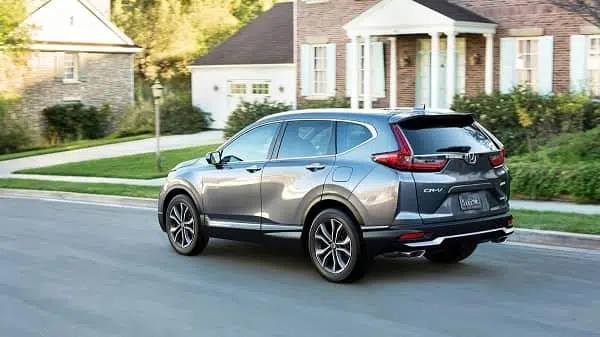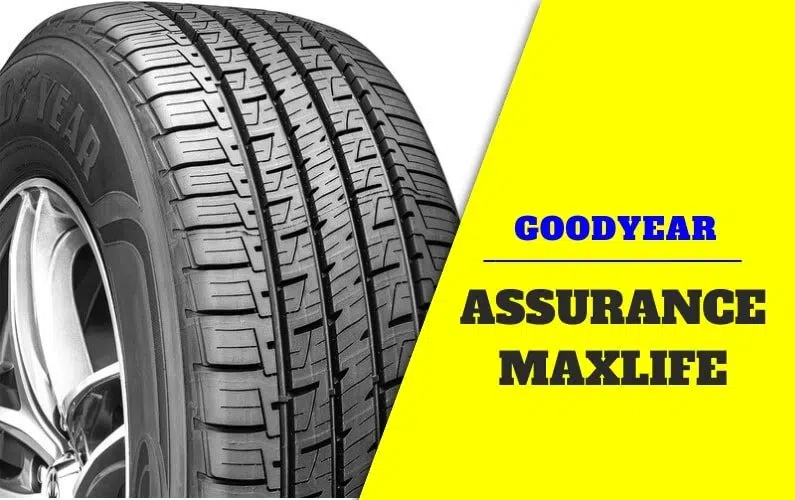“This post contains affiliate links, and I will be compensated if you make a purchase after clicking on my links.”
Pros
-
Excellent cornering grip for a long-lasting touring tire
-
Dry traction and braking are among the best in the category
-
Easy to drive in wet conditions – it’s very controllable at the limit
-
Wet traction and braking are very solid
-
Excellent hydroplaning resistance, even in heavy rain
-
The treadlife is simply exceptional
-
Outstandingly long treadwear warranty
-
Good ice traction and braking for an all-season tire
Cons
-
The dead spot at center hurts responsiveness and steering feel
-
Uncomfortable over larger bumps and undulations on the road
-
Snow braking distances are much longer other premium competitors
-
Handling on snow doesn’t compare to the best in the category
Get Up to $240 Back on Goodyear Tires
Valid through March 31, 2023
Available at TireRack.com
Perhaps the most critical quality that drivers search for in tires is durability. Nobody wants to replace the tires often, mainly because a set of four can be a very costly purchase on modern cars with large wheels.
And, when it comes to durability and treadlife, standard touring tires are by far the best choice. On paper, one of the most impressive tires in this category is the Goodyear Assurance MaxLife. Designed to last for a very long time, but also to give the driver surefooted handling in most conditions, Goodyear’s durable tire promises to be one of the best touring tires on the market right now.
There is a problem with that approach, though. Engineers have tried for decades to make tires both durable and grippy, but most of the time, to no avail. To put it simply, you can’t make a rubber compound that’s durable and resistant to abrasion, without losing some traction. The stickier the rubber compound, the faster it degrades.
However, some premium manufacturers, such as Goodyear, Bridgestone, Michelin, Continental, and Pirelli, have some of the best rubber engineers on the planet. And, if someone knows how to make tires that will satisfy on both ends, it will undoubtedly be those companies.
Moreover, making touring tires great to drive also requires a lot of research, development, and testing, something those companies certainly don’t lack.
For that reason, I will enter the Goodyear Assurance MaxLife review with a mildly high expectation. Goodyear utilized its latest technologies to make this tire perform well and last for long, which is always a good sign.
Furthermore, the company announced the Assurance MaxLife at the beginning of 2018, which means that it’s one of the newest standard touring all-season tires. And, when a new premium tire launches, it usually sets the tone in the category.
So how does Goodyear’s new entry compare to the rivals? You can find out in my detailed Goodyear Assurance MaxLife review, where I’ll cover treadlife, all-season traction, and comfort.
New Year Sale @Priority Tire
Valid through January 13, 2023
Available at PriorityTire.com
What are the features of the Goodyear Assurance MaxLife?
The Assurance MaxLife is the highest-mileage tire in the history of Goodyear, which is not a small feat considering the reputation of the company.
“The Goodyear Assurance MaxLife combines years of experience with today’s technology to deliver long-wear characteristics, reliability, and great value for consumers,” said Andy Traicoff, vice president, North America Sales, when Goodyear announced the tire.
To achieve all these things, the company utilized its TredLife Technology. According to Goodyear, thanks to this tech, the Assurance MaxLife can provide the driver with 30% more miles of all-season traction than a regular all-season tire.
The advanced rubber compound used on the Assurance MaxLife is molded into a symmetric tread pattern. The design Goodyear chose features a continuous center rib for constant contact with the road, increased responsiveness, and better on-center feel.
Meanwhile, the notched intermediate ribs and semi-closed shoulders give the tire better directional stability and cornering grip. For better water evacuation and wet traction, Goodyear utilized four wide circumferential grooves and block edges.
The Assurance MaxLife also features many sipes across the tread blocks, which give additional biting edges for increased traction on snow and ice.
The internal construction of the Assurance MaxLife consists of twin steel belts reinforced by spirally wound nylon on top of a single-ply polyester casing. This design gives the tire better handling response and high-speed capability, but also improved ride quality.
The Assurance MaxLife comes in 45 sizes, ranging from 15-inch wheel diameter and up to 20-inch wheel diameter. With these dimensions, Goodyear covers a large portion of cars available on the roads today.
The smaller sizes, for example, are an excellent fit for compact cars, such as Ford Fiesta, Honda Fit, Toyota Corolla, Honda Civic, Ford Focus, and older sedans, such as older Camry’s and Accord’s.
Then, 17-inch and larger sizes are a great fit for modern mid-size sedans, minivans, and even SUVs and crossovers, such as Ford Escape, Honda CR-V, Kia Sorrento, and Toyota RAV4.
Ultimately, larger sizes will be an excellent fit for coupes, albeit not very sporty ones, and also for premium sports sedans, such as BMW 3-Series, Lexus IS, Audi A4, and Mercedes C-Class, but also larger vehicles like Lexus ES, BMW 5-Series, Audi A6, and Mercedes-Benz E-Class.
What are the maintenance indicators?
The Assurance MaxLife is equipped with Goodyear’s new Wear Gauge design, which helps the driver better monitor the tread depth of the tire. Essentially, Goodyear decided to imprint the 2, 4, 6, and 8 numbers inside the grooves of the tire.
These numbers signify how much tread depth is left. For example, the number 8 means that the tire has 8/32 inch of tread depth left, the number 6 means 6/32 inch, etc. The number 2 is the lowest because 2/32 is considered the lowest depth when the tire is still able to provide usable wet traction.
Apart from the excellent Wear Gauge marks, the Assurance MaxLife also comes with the regular TWI’s (tread wear indicators). These indicators are narrow rubber bars built and recessed into the grooves of the tire.
As the tread wears down, the TWI’s become more visible. When the tread depth falls down to 2/32-inch, the TWI’s will be completely flush with the surface of the tread. At that point, you should replace the tires.
Fortunately, the Assurance MaxLife is one of the longest-lasting tires on the market. Sure, I can’t tell you if it’s the most durable – the tire is still very new, and not many owners covered more than 30,000 to 40,000-miles.
But I can tell you that the treadwear warranty is simply exceptional at 85,000-miles for all sizes. Right now, that’s the best result of any premium all-season touring tire, and a testament of Goodyear’s prowess in engineering.
How does it behave on a dry tarmac?

The Assurance MaxLife doesn’t impress at first. The tire feels dead on-center, which hurts responsiveness a lot. This might not be important to most drivers, but I think that those that own performance sedans might find it irritating.
On a more positive note, the Assurance MaxLife is very competitive in terms of grip and traction. You can achieve very high cornering speeds without worrying about losing traction, which is impressive for a tire designed for durability.
Moreover, the braking distances are among the shortest in the category, and the tire feels stable and surefooted on the highway.
How is it over wet and slippery roads?
Interestingly, the tire feels better in wet conditions. Unlike some cheaper all-season tires, you can easily control the Assurance MaxLife at the limit, even in heavy rain. To put it simply, the tire feels very safe behind the wheel on wet surfaces.
In terms of outright traction and braking on wet pavement, the Assurance MaxLife is a step behind the class-leading tire, the Continental TrueContact Tour.
If we put the Continental out of the contest, though, the Assurance MaxLife is one of the best all-season touring tires in wet conditions and on-par with other premium tires.
With that being said, how is it on snowy roads?
The sub-par snow performance is the only significant disadvantage of the Assurance MaxLife. You can still use this tire on light snow – the traction and braking are usable. However, you will get much better snow traction from other competitors, such as the aforementioned TrueContact Tour.
Interestingly, though, the Assurance MaxLife beats the competition on icy surfaces. The difference is not significant, and you should definitely opt for a winter tire for those conditions, but a win is a win.
Is it suitable for off-road driving?
The Assurance MaxLife can be installed on many crossovers and SUVs, sure, but that doesn’t mean that you should trust it for off-roading. The tire simply lacks enough traction on slippery surfaces, and the tread compound doesn’t have any protection from cuts and punctures.
Is it comfortable and refined?
Even though it’s a touring tire designed for covering long distances, the Assurance MaxLife isn’t the most comfortable around. The ride is firm on most surfaces, and larger undulations can be clearly felt in the cabin. Also, while the tire isn’t very noisy, it’s still noisier than most premium competitors.
You can see more Goodyear Assurance MaxLife Review here: Video created by Campus Automotive Inc
Should I buy the Goodyear Assurance MaxLife?
If you want the longest-lasting all-season tire on the market, you should definitely buy the Assurance MaxLife. Goodyear provides an unbeatable 85,000-mile treadwear warranty on the tire, while still providing you with safe and stress-free traction in most conditions.
That said, I think you should also consider the Continental TrueContact Tour, which is overall a slightly better product, and the Michelin Defender T+H, which shares similar qualities.
Get Up to $240 Back on Goodyear Tires
Valid through March 31, 2023
Available at TireRack.com



Purchased a set 2 years ago,now have just over 26,000 miles and 6/32 of tread left till tires are bald,with regular rotations at 5,000 miles. Not impressed with tire salesman telling me they have 3/4 life left. And these cannot even touch the 75,000 miles on a set of Goodyear allegra purchased in 2000 which when purchased for a dodge caravan about 4 years later failed to hold up for 75,000 miles. Bottom line,most tires wear about 1/32 in 5,000 miles.
I want to know which is affordable on real good all season tires. Something like 60$$ each.